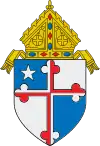The Most Reverend Ambrose Maréchal | |
|---|---|
| Archbishop of Baltimore | |
 | |
| See | Archdiocese of Baltimore |
| Appointed | July 4, 1817 |
| Installed | December 14, 1817 |
| Term ended | January 29, 1828 |
| Predecessor | Leonard Neale, S.J. |
| Successor | James Whitfield |
| Orders | |
| Ordination | June 2, 1792 |
| Consecration | December 14, 1817 by Jean-Louis Lefebvre de Cheverus |
| Personal details | |
| Born | August 28, 1764 |
| Died | January 19, 1828 (aged 63) Baltimore, Maryland United States |
| Motto | Auspice Maria (Under the protection of Mary). |
| Signature | |
Ambrose Maréchal, P.S.S. (August 28, 1764 – January 29, 1828) was an American Sulpician and prelate of the Roman Catholic Church who served as the third Archbishop of the Archdiocese of Baltimore in Maryland. He dedicated the Basilica of the National Shrine of the Assumption of the Blessed Virgin Mary, the oldest cathedral in the United States, in Baltimore in 1821.
Biography
Ambrose Maréchal was born at Ingré in France on August 28, 1764. Following his parents' wishes, he began studies for the legal profession. However, he later decided to enter the Saint-Sulpice Seminary at Issy-les-Moulineaux, France. The Sulpician Order gave Maréchal his tonsure, a special haircut allowing a seminarian to continue his studies, at the end of 1787.[1][2]
Due to popular unrest in the Paris area, Maréchal left for Bordeaux, France, in early 1792. He was ordained there into the priesthood on March 25, 1792, by Archbishop Archbishop Jérôme-Marie Champion de Cicé.[3][1] Bishop John Carroll in 1791 had invited the Sulpicians to Baltimore, Maryland to establish St. Mary's Seminary, the first Catholic seminary in the new United States.[4]
The Sulpician Order in the spring of 1792 sent Maréchal to the United States to help staff St. Mary's. He arrived Baltimore on June 24, 1792, where he celebrated his first mass as a new priest.[5] After spending time at the seminary, he was assigned by the Sulpicians to perform pastoral work in Bohemia, Maryland. By 1799, Maréchal was back in Baltimore, teaching theology at the seminary. In 1801, Maréchal was sent to teach philosophy at the new Georgetown College in Washington, D.C.[6]
With the ascension of Napoleon Bonaparte as first consul of the new French Republic, it became safer for Catholic clergy to practice in France. In 1803, the Sulpicians ordered Maréchal to return to France. He would spend the next nine years teaching at Sulpician schools in Saint-Flour, Lyon, Aix-en-Provence and Marseilles. Maréchal's students in Marseilles presented him with a marble altar. Louis XVIII, who became the French monarch in 1814, later presented him with several paintings. The altar and the paintings went to the Basilica of the Assumption in Baltimore.[1]
In 1812, the Sulpicians sent Maréchal to Baltimore, where he resumed teaching at St. Mary's, where for a time he also served as president. [1]
Archbishop
In 1816 he was nominated Bishop of Philadelphia, but at his request the nomination was withdrawn and, on July 24, 1817, he was appointed Coadjutor bishop to Archbishop Leonard Neale of Baltimore, and Titular of Stauropolis. The brief of the appointment had not reached Baltimore when Archbishop Neale died, and Maréchal was not consecrated Archbishop of Baltimore by Bishop Cheverus of Boston until December 14, 1817.[1]
Maréchal indicated that the most pressing problems facing the Archdiocese were the shortage of priests and rebellious trustees who wished to determine where those few be assigned.[7] This appeared to be a particular problem in parishes with a dominant number of Irish immigrants, who would support a particular cleric regardless of how unsuitable or unqualified.[8] In 1820 Bishop Flaget of Bardstown warned Maréchal of an individual who seemed to have the appropriate letters of introduction, but upon observing him say Mass, appeared not to be a priest at all. Maréchal advised the Propaganda Fide (Congregation for the Evangelization of Peoples) of the matter of problematic Irish priests being given letters of transfer by their bishops.[9] During his tenure, the dioceses of Richmond and Charleston were created.[5]
The building of the Baltimore Basilica, the first Catholic Cathedral built in the United States, which had been begun under Archbishop John Carroll in 1806, was now resumed and completed and was dedicated on May 31, 1821, under the title of the Assumption of the Blessed Virgin Mary.[1]
Also in 1821, Maréchal went to Rome on business of his diocese, and in connection with the White Marsh plantation which the Archbishop claimed as Diocesan property, but which had been given to the Jesuits on February 17, 1728, and was claimed by them as property of the Society to be employed in the interests of the Church of Maryland.[10] The archbishop secured from Rome a Bull in his favour.[1]
In 1826 Maréchal made a journey to Canada, and on his return fell ill. He died at age 63 on January 29, 1828, in Baltimore.[5] His coadjutor, James Whitfield, who succeeded him as Archbishop of Baltimore, had not yet been consecrated when Maréchal died. Maréchal's body is interred in the Baltimore Basilica's crypt, and his heart is in the chapel behind Elizabeth Ann Seton's house in downtown Baltimore.
Works
His writings consist almost entirely of letters and documents scholarly in style, and are to be found in "The History of the Society of Jesus in North America" by Hughes.
See also
Notes
- 1 2 3 4 5 6 7 "CATHOLIC ENCYCLOPEDIA: Ambrose Marechal". www.newadvent.org. Retrieved 2023-12-02.
- ↑ "Province of France". Compagnie des Prêtres de Saint-Sulpice - Généralat. Retrieved 2023-12-02.
- ↑ "Archbishop Jérôme-Marie Champion de Cicé [Catholic-Hierarchy]". www.catholic-hierarchy.org. Retrieved 2023-12-02.
- ↑ "The Seminary". Saint Mary's Seminary & University. Retrieved 2023-12-02.
- 1 2 3 "Most Rev. Ambrose Maréchal S.S. | Archdiocese of Baltimore". Archdiocese of Baltimore. Retrieved 2018-08-17.
- ↑ Clarke, Richard Henry. "Most Rev. Ambrose Maréchal, D.D.", Lives of the Deceased Bishops of the Catholic Church in the United States, Vol. 1, P. O'Shea, 1872
- ↑ Gleeson, David T., The Irish in the South, 1815-1877, Univ of North Carolina Press, 2002, ISBN 9780807875636, p. 76
- ↑ Burns, Jeffrey M.; Skerrett, Ellen; White, Joseph M. (2006-09-01). Keeping Faith: European and Asian Catholic Immigrants. Wipf and Stock Publishers. ISBN 9781597529082.
- ↑ Dichtl, John R., Frontiers of Faith: Bringing Catholicism to the West in the Early Republic, University Press of Kentucky, 2008, ISBN 9780813138817
- ↑ "Sacred Heart Church - The Parish with Colonial Roots - since 1728". www.sacredheartbowie.org. Retrieved 2018-08-17.
References
 This article incorporates text from a publication now in the public domain: McNeal, James Preston Wickham (1910). "Ambrose Maréchal". In Herbermann, Charles (ed.). Catholic Encyclopedia. Vol. 9. New York: Robert Appleton Company.
This article incorporates text from a publication now in the public domain: McNeal, James Preston Wickham (1910). "Ambrose Maréchal". In Herbermann, Charles (ed.). Catholic Encyclopedia. Vol. 9. New York: Robert Appleton Company.
